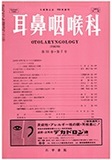Japanese
English
- 有料閲覧
- Abstract 文献概要
- 1ページ目 Look Inside
鼻汁にはさまざまな体細胞およびその変性したものが現われる。遊走細胞にせよ,剥離細胞にせよ,その母地である鼻粘膜の組織レベルでの異常を反映しているものであり,たとえ個々の細胞自身の変化であつても,それは母組織の異常と密接な関係にあるものと言えよう。逆に言えば,鼻汁中に出現したいろいろな細胞の観察から,鼻粘膜の病的状態を的確に判断することができるはずである。
前世紀の終り頃より鼻茸,鼻カタル,血管運動性鼻炎や喘息患者の鼻汁中に好酸球が出現することがひろく認められてきたが,鼻汁細胞診がアレルギーの診断上重要視されるようになつたのはEyermann(1927)1),Hansel(1929)2)などの業績がでた頃からである。本邦でも藤沢3)がすでに1934年に鼻汁好酸球の診断価値について報告している。そしてHilding(1930)4),Bryan(1950)5)らの感冒時粘膜上皮の変性に関する観察や,坂井(1956)6)の実験的副鼻腔炎における線毛細胞の変化に関する観察,Bryan(1959)ら7)の肥満細胞の仕事などを綜合すると,おおよそあらゆる炎症性鼻疾患の鼻汁中に現われる細胞の概観が理解でき,これをまとめればBryanが述べているような細胞表(Cytogram)8)ができあがり,鼻疾患の診断,経過観察のうえで役立つものと考えられる。
Common cold, acute bacterial rhinitis, chronic rhinitis and nasal allergy could be differenciated by observations on cytology of the nasal secretions. In cases of common cold, forty two smears out of 61 showed ciliocytophthoria (CCP) or tufts positive. Shortened ciliated epithelial cells were observed in many acute infectious cases, while elongated ones in chronic cases. The clinical correlation between eosinophils and nasal allergy was frequently found to be very striking. Mast cells were observed in 45.7% of acute exacerbated allergic cases and in 42. 2% of quiescent allergic cases, but in less than 25% of infectious cases.

Copyright © 1979, Igaku-Shoin Ltd. All rights reserved.


